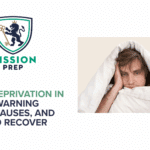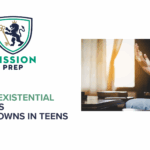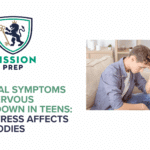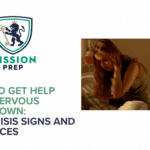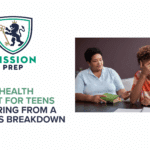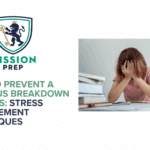What Causes Emotional Overload?
Nervous Breakdown Triggers in Teen Girls & Support Available

Teen girls today face mounting emotional and mental health pressure from multiple directions, including academic expectations, peer dynamics, identity development, and the omnipresence of social media.
With so many pressures, it’s no real wonder that nearly 3 in 5 teen girls report persistent feelings of sadness or hopelessness.¹ And while many people assume this is just a passing phase or mood swing, the combination of stressors can create a foundation for chronic stress and potential mental breakdown.
Fortunately, understanding the cause of emotional overload in teen girls helps families and providers respond with appropriate support rather than assuming the issue is hormonal or behavioral alone.
To help you understand nervous breakdown in teen girls, this guide explores:
- What emotional overload in teen girls is
- Signs and triggers for breakdowns in girls
- How to go about supporting teen girls’ mental health
- How Mission Prep can help teen girls in distress

What Is Emotional Overload in Teen Girls?
Emotional overload in teen girls happens when feelings build up so much that they become too hard to manage. Research shows that in most healthy nervous systems, negative emotions are counterbalanced by positive ones.² But sometimes, when negative emotions aren’t correctly counterbalanced, the system becomes dysfunctional and emotional overload may occur as a result. Teen girls are particularly susceptible to this.
One reason emotional regulation is harder for teens is that their brains are still developing and will continue to do so until their mid-twenties.³ During adolescence, the part of the brain that reacts to stress and strong emotions (the amygdala) becomes more sensitive.⁴ But the part that helps with reasoning and calming down (the prefrontal cortex) is still catching up.⁵
Another factor is the major hormonal shifts associated with the teen years. When a teen’s hormones are all over the place, it’s no surprise that regulating emotions gets harder, especially during stressful moments.
And finally, there are the compounding effects of mental health difficulties. For girls dealing with things like perfectionism, social anxiety, or body image struggles, even regular school or social stress can feel like too much.
Over time, repeated stress can train the brain to stay on high alert, even when there’s no immediate danger.⁶ If this goes on for too long, it can lead to a female teen mental breakdown, which is a point where their brain and body say, “I can’t handle any more.”
Fortunately, with the right support, things really can get better. The first step is recognizing what’s happening, which is a whole lot easier once you know the signs.
Signs of Female Teen Mental Breakdown
A female teen mental breakdown can start out with small changes like less energy, more tears, or trouble sleeping, but can snowball into more serious outcomes if left unaddressed.
Here are some signs of mental health challenges resulting from a mental breakdown to watch for:
- Sudden mood swings or emotional outbursts that seem out of proportion to the situation⁷
- Extreme fatigue or low motivation, even for things they once enjoyed, are often signs of depression setting in⁸
- Withdrawal from friends, family, or usual routines⁹
- Increased sensitivity to criticism or perceived rejection¹⁰
- Changes in sleep patterns, like insomnia or oversleeping¹¹
- Physical complaints without a clear medical cause, such as headaches, nausea, or body aches¹²
- Heightened social anxiety in girls, including fear of embarrassment or social judgment¹³
- Negative body image and emotional health struggles, like obsessing over appearance or eating habits¹⁴
- School pressure in teen girls becoming a source of panic, avoidance, or breakdowns over assignments¹⁵
- Trouble concentrating or remembering things, especially during stressful periods¹⁶
As emotional sensitivity in youth can present differently in girls, some might appear high-functioning, meaning their grades may still be high, and they may appear smiley throughout the day, even while struggling intensely. These breakdowns often happen behind closed doors, especially when peer conflict and stress go unnoticed or unresolved.
But what causes the tipping point? Let’s explore the triggers for breakdowns in teen girls next.
What Are the Triggers for Breakdowns in Girls?
While the underlying causes of emotional overload often relate to mental health pressure, perfectionism, or biology, triggers are the specific events or stressors that activate these vulnerabilities.
Some common triggers for breakdowns in girls may include:
- Peer conflict and stress: A fallout with a close friend, bullying, or feeling excluded can push a girl into crisis mode quickly. Social disconnection cuts deep when belonging is a core emotional need.
- Sudden academic stress: Bad grades, a missed deadline, or feeling unprepared for an exam can act as a final straw, especially when school pressure in teen girls is tied to their self-worth.
- Family tension or change: Divorce, loss, or ongoing arguments at home create an unstable emotional foundation.
- Social comparison and online pressure: Social media often amplifies body image and emotional health struggles. A single post or message can trigger days of self-doubt or shame.
- Romantic rejection: For some teens, early romantic experiences carry enormous emotional weight. A breakup or betrayal can trigger spiraling thoughts of inadequacy or abandonment.
- Major life transitions: Moving schools or puberty can unearth insecurity and overwhelm in emotionally sensitive youth.
- Perfectionism in adolescent females: When they can’t meet impossibly high standards, either their own or someone else’s, they often feel inadequate.
- Hormonal impact: While hormones don’t cause breakdowns on their own, they can heighten emotional reactivity and intensify feelings of sadness, rage, or hopelessness.
- Loneliness and isolation: Especially in high-achieving girls, the pressure to appear okay can lead them to hide their pain.
Understanding these triggers can not only help teens and parents identify what’s going on. But they can also help professionals offer support before a full female teen mental breakdown occurs.
Types of Treatment Options for Supporting Teen Girls’ Mental Health
When emotional overload builds to a breaking point, it becomes about more than calming a single crisis or preventing the next one. It’s about creating long-term support that actually meets the needs of adolescent girls. That means looking beyond symptom control and addressing the emotional, social, and biological layers at play.
Below are some appropriate treatment options tailored for supporting teen girls struggling with mental breakdown:
Trauma-Informed Therapy
Many teen girls carry invisible emotional injuries, from bullying and peer exclusion to family instability or early relationship distress. A trauma-informed therapist recognizes the subtle signs of nervous system overwhelm and avoids re-triggering shame.
This approach is especially helpful for girls with emotional sensitivity in youth, where past events may still instigate present reactions.
Cognitive Behavioral Therapy (CBT)
CBT is often the go-to for treating adolescent girls with depression, anxiety, and social withdrawal. It helps teens identify thought patterns that fuel overwhelm, such as perfectionism, catastrophizing, or black-and-white thinking, all of which are common in girls under mental health pressure.¹⁷
Dialectical Behavior Therapy (DBT)
DBT includes mindfulness, distress tolerance, and emotion regulation strategies.¹⁸ These help girls manage emotional overload in real time. It’s particularly helpful for girls who feel things deeply and may spiral quickly when triggered.
Female-Specific Group Therapy
For girls who feel isolated, group therapy with peers facing similar issues offers a lifeline. This kind of female-specific therapy can provide validation and belonging while helping girls explore identity, self-esteem, and relational challenges in a safe space.¹⁹
Medication Support
When things like depression, anxiety, or big mood swings start making everyday life really hard, medication might be one piece of the bigger healing puzzle. Doctors sometimes prescribe SSRIs (a type of antidepressant) to help balance mood, but these work best when paired with therapy, support, and healthy daily routines, not on their own.²⁰
Family Therapy or Systems-Based Care
Sometimes, what looks like a breakdown is really a reaction to stress at home. Bringing parents or caregivers into therapy can help rebuild trust, improve how everyone communicates, and create a stronger sense of emotional safety for the teen.²¹
School-Based Support Plans
Working with school counselors, special education staff, or mental health coordinators can ensure that school pressure in teen girls is managed with compassion.²² Flexible deadlines, wellness check-ins, or adjusted workloads can prevent further emotional overload.
Holistic and Lifestyle-Based Interventions
Movement, sleep, and nutrition all impact mood regulation. For example, regulating blood sugar and supporting hormonal balance can ease emotional reactivity. Even gentle, consistent movement can help girls manage social anxiety, build confidence, and process stress in healthier ways.²³

Reach Out to Mission Prep for Female Teen Mental Breakdown Help
When a teen starts showing signs of emotional distress or burnout, early support makes all the difference.
At Mission Prep, we offer therapeutic support tailored to the unique mental health needs of adolescent girls. Our approach considers the full picture, including hormonal shifts, social anxiety, perfectionism, and emotional sensitivity. Whether your family prefers a faith-based or non-faith-based path, our team is here to walk alongside you.
We don’t just aim to reduce symptoms. We help teen girls reconnect with their sense of safety, identity, and emotional strength. If your daughter is struggling, reach out to learn more about how we can support her healing and resilience.
References
- Centers for Disease Control and Prevention. (2024, July 9). U.S. teen girls experiencing increased sadness and violence. https://www.cdc.gov/media/releases/2023/p0213-yrbs.html
- De Berardis, D., Fornaro, M., Orsolini, L., Ventriglio, A., Vellante, F., & Di Giannantonio, M. (2020). Emotional dysregulation in adolescents: Implications for the development of severe psychiatric disorders, substance abuse, and suicidal ideation and behaviors. Brain Sciences, 10(9), 591. https://pmc.ncbi.nlm.nih.gov/articles/PMC7565002/
- Mercurio, E., García-López, E., Morales-Quintero, L. A., Llamas, N. E., Marinaro, J. Á., & Muñoz, J. M. (2020). Adolescent brain development and progressive legal responsibility in the Latin American context. Frontiers in Psychology, 11, 627. https://www.frontiersin.org/journals/psychology/articles/10.3389/fpsyg.2020.00627/full
- Tottenham, N., & Galván, A. (2016). Stress and the adolescent brain: Amygdala-prefrontal cortex circuitry and ventral striatum as developmental targets. Neuroscience and Biobehavioral Reviews, 70, 217–227. https://pmc.ncbi.nlm.nih.gov/articles/PMC5074883/
- Arain, M., Haque, M., Johal, L., Mathur, P., Nel, W., Rais, A., Sandhu, R., & Sharma, S. (2013). Maturation of the adolescent brain. Neuropsychiatric Disease and Treatment, 9, 449–461. https://pmc.ncbi.nlm.nih.gov/articles/PMC3621648/
- Eiland, L., & Romeo, R. D. (2013). Stress and the developing adolescent brain. Neuroscience, 249, 162–171. https://pmc.ncbi.nlm.nih.gov/articles/PMC3601560/
- Gregorová, K., Eldar, E., Deserno, L., & Reiter, A. M. F. (2024). A cognitive-computational account of mood swings in adolescence. Trends in Cognitive Sciences, 28(4), 290–303. https://www.sciencedirect.com/science/article/pii/S1364661324000330
- Higson-Sweeney, N., Cooper, K., Dunn, B. D., & Loades, M. E. (2024). “I’m always going to be tired”: A qualitative exploration of adolescents’ experiences of fatigue in depression. European Child & Adolescent Psychiatry, 33(5), 1369–1381. https://pmc.ncbi.nlm.nih.gov/articles/PMC10257178/
- Barzeva, S. A., Meeus, W. H. J., & Oldehinkel, A. J. (2019). Social withdrawal in adolescence and early adulthood: Measurement issues, normative development, and distinct trajectories. Journal of Abnormal Child Psychology, 47(5), 865–879. https://pmc.ncbi.nlm.nih.gov/articles/PMC6469640/
- Chen, Q., Bonduelle, S. L. B., Wu, G.-R., Vanderhasselt, M.-A., De Raedt, R., & Baeken, C. (2024). Unraveling how the adolescent brain deals with criticism using dynamic causal modeling. NeuroImage, 286, 120510. https://www.sciencedirect.com/science/article/pii/S1053811924000053
- Uccella, S., Cordani, R., Salfi, F., Gorgoni, M., Scarpelli, S., Gemignani, A., Geoffroy, P. A., De Gennaro, L., Palagini, L., Ferrara, M., & Nobili, L. (2023). Sleep deprivation and insomnia in adolescence: Implications for mental health. Brain Sciences, 13(4), 569. https://pmc.ncbi.nlm.nih.gov/articles/PMC10136689/
- Nilsen, M., Weider, S., Halse, M. K., Fiskum, C., & Wichstrøm, L. (2023). Association of anxiety and depression to headache, abdominal- and musculoskeletal pain in children. Frontiers in Pain Research, 4, 1136145. https://www.frontiersin.org/journals/pain-research/articles/10.3389/fpain.2023.1136145/full
- Leigh, E., & Clark, D. M. (2018). Understanding social anxiety disorder in adolescents and improving treatment outcomes: Applying the cognitive model of Clark and Wells (1995). Clinical Child and Family Psychology Review, 21(3), 388–414. https://pmc.ncbi.nlm.nih.gov/articles/PMC6447508/
- Ganesan, S., Ravishankar, S. L., & Ramalingam, S. (2018). Are body image issues affecting our adolescents? A cross-sectional study among college going adolescent girls. Indian Journal of Community Medicine, 43(Suppl 1), S42–S46. https://pmc.ncbi.nlm.nih.gov/articles/PMC6324036/
- Jiang, M.-M., Gao, K., Wu, Z.-Y., & Guo, P.-P. (2022). The influence of academic pressure on adolescents’ problem behavior: Chain mediating effects of self-control, parent-child conflict, and subjective well-being. Frontiers in Psychology, 13, 954330. https://pmc.ncbi.nlm.nih.gov/articles/PMC9534181/
- Burns, R. D., Pfledderer, C. D., & Fu, Y. (2021). Adolescent health behaviors and difficulty concentrating, remembering, and making decisions. American Journal of Lifestyle Medicine, 15(6), 664–672. https://pmc.ncbi.nlm.nih.gov/articles/PMC8669897/
- Orsillo, S. M., & Batten, S. V. (2005). Acceptance and commitment therapy in the treatment of posttraumatic stress disorder. Behavior Modification, 29(1), 95–129. https://www.researchgate.net/profile/Susan-Orsillo/publication/8170794_Acceptance_and_Commitment_Therapy_in_the_Treatment_of_Posttraumatic_Stress_Disorder/links/0deec53571a7d0cdb0000000/Acceptance-and-Commitment-Therapy-in-the-Treatment-of-Posttraumatic-Stress-Disorder.pdf
- Geddes, K., Dziurawiec, S., & Lee, C. W. (2013). Dialectical behaviour therapy for the treatment of emotion dysregulation and trauma symptoms in self-injurious and suicidal adolescent females: A pilot programme within a community-based child and adolescent mental health service. Psychiatry Journal, 2013, 145219. https://pmc.ncbi.nlm.nih.gov/articles/PMC3820084/
- Nazmi, S., Nikbakht, H.-A., Gholamnia-Shirvani, Z., Behmanesh, F., & Azizi, A. (2024). The effectiveness of pubertal health group counseling based on problem-solving, on body image concerns and anxiety in adolescent girls: Study protocol. Journal of Education and Health Promotion, 13(1), 215. https://pmc.ncbi.nlm.nih.gov/articles/PMC11410170/
- Hazell, P. (2022). Antidepressants in adolescence. Australian Prescriber, 45(2), 49–52. https://pmc.ncbi.nlm.nih.gov/articles/PMC9081936/
- Berry, K. R., Gliske, K., Schmidt, C., Ballard, J., Killian, M., & Fenkel, C. (2023). The impact of family therapy participation on youths and young adult engagement and retention in a telehealth intensive outpatient program: Quality improvement analysis. JMIR Formative Research, 7, e45305. https://pmc.ncbi.nlm.nih.gov/articles/PMC10160927/
- Shahraki-Sanavi, F., Ansari-Moghaddam, A., Mohammadi, M., Bakhshani, N.-M., & Salehiniya, H. (2020). Effectiveness of school-based mental health programs on mental health among adolescents. Journal of Education and Health Promotion, 9(1), 142. https://pmc.ncbi.nlm.nih.gov/articles/PMC7377131/
- Shakoor, A., Fatima, T., Hanif, S., & Jafri, M. (2025). Analyzing how physical health factors such as sleep, nutrition, and exercise influence mental health outcomes. The Critical Review of Social Sciences Studies, 3(1), 2152–2164. https://www.researchgate.net/publication/389206457_Analyzing_how_physical_health_factors_such_as_sleep_nutrition_and_exercise_influence_mental_healh_outcomes

